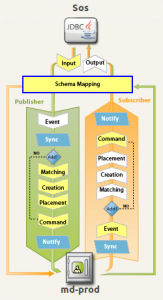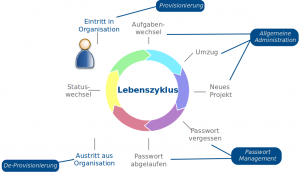Was einst mit einer Idee, oder der vergeblichen Google-Suche nach dem passenden Icon, begann hat nun eine erstaunliche Marke erreicht: das offizielle RRZE-Icon-Set hat sein 400. Icon!
Aufgrund dieser großen Zahl an verschiedenen Icons und ihrer unterschiedlichen Verwendung wurde die Anzahl der Unterordner um zwei weitere erweitert. Mittlerweile sind die Icons also aufgeteilt in:
- actions (Technische Aktionen, wie etwa: Sortieren, Zusammenfügen, das Verschicken von E-Mails, etc.)
- categories (Verschiedene Zugehörigkeiten wie: Arbeitnehmer, Admin, Benutzer, etc.)
- devices (Im allgemeinen IT-Hardware wie: Server, Datenbank, etc.)
- NEU: documents (Dokumente aller Art)
- emblems (Der größte Ordner umfasst alle Icons die ein Label oder ein konkretes Bild für einen abstrakten Begriff oder eine Funktion darstellen.)
- NEU: logos (Hier befinden sich alle Icons die in irgendeiner Weise ein Logo beinhalten.)
- mime-types (Hier lassen sich Icons für verschiedene Medientypen finden: Text, Video, Audio, etc.)
- status (Alle Icons, die einen Status darstellen: wartend, geprüft, gelöscht, etc.)
Das hauseigene Icon-Set stellt “kleine bunte Bildchen” zu verschiedenen IT-Themen, Aktionen, Funktionen und vielem mehr zur Verfügung.
Um einen einheitlichen Stil zu erhalten werden bei der Erstellung die Vorgaben des Tango-Icon-Themes eingehalten.
Verfügbar sind die Icons im Svg- (jeweils eine detailreiche und eine detailärmere Variante für die kleineren Skalierungen) und im Png-Format in den Größen 16×16, 22×22, 32×32, 48×48, 150×150 und 720×720 Pixel und können direkt auf der Seite heruntergeladen werden.
Falls allerdings das passende Icon immer noch fehlen sollte lässt sich dieses jederzeit noch der Sammlung hinzufügen. Hierfür einfach eine E-Mail an franziska.sponsel@fau.de schicken.
Wichtig bei der “Icon-Bestellung” ist allerdings, dass folgende Grundinformationen in der Mail stehen:
1. Welche Funktion etc. soll das Icon haben bzw. darstellen? Am besten auch für IT-Laien verständlich 😉
2. Gibt es schon konkrete Vorstellungen zum Aussehen (z.Bsp. ein Häuschen für “home”) oder Farbwünsche?
Es sollte auch immer darauf geachtet werden, dass durch die kleine Skalierung ein Icon aus nicht mehr als maximal 3 Bestandteilen bestehen kann.
Mittlerweile hat das RRZE-Icon-Set die Versionsnummer 2.3 erreicht und hat in einer Vielzahl von Projekten Anklang und Verwendung gefunden. Sowohl hier in Erlangen in RRZE eigenen Projekten, aber auch in anderen Arbeiten und Projekten in Deutschland, Indien bis hin zum sonnigen California, USA.
What once started off with an idea, or a fruitless Google search for the perfect Icon, has now reached an incredible benchmark: the official RRZE Icon Set got its 400. icon!
Because of this huge number of various icons and their different usage, the number of sub-folders has been expanded by two additional folders. Therefore the icons are now divided into:
- actions (technical actions, e.g.: sort, merge, send e-mails, etc.)
- categories (different entitlement or categories, e.g.: employee, admin, user, etc.)
- devices (generally IT-hardware, e.g.: server, databases, etc.)
- NEW: documents (documents of all kind)
- emblems (the biggest folder concludes all icons which represent a label or a proper picture for an abstract term or function)
- NEW: logos (here you can find icons which represent or conclude a logo)
- mime-types (icons for different media types, e.g.: text, video, audio, etc.)
- status (icons that represent a status, e.g.: awaiting, approved, deleted, etc.)
The RRZE own icon set offers “tiny colorful pictures” for various IT topics, actions, functions and many more.
To create a consistent style the icons are made according to the style sheet of the Tango Icon Theme.
The icons are available in svg- (a more and a less detailed version for smaller scaled icons) and in png-format in the sizes 16×16, 22×22, 32×32, 48×48, 150×150 and 720×720 pixels and can be downloaded directly from the website .
If the perfect icon for a purpose is still missing it can easily be added to the set. Therefore don’t hesitate to send a request e-mail to franziska.sponsel@fau.de.
Important for the “Icon-Order” is that the following basic information is given and in the e-mail:
1. What function etc. should the icon represent? The best way is to explain it that even an ordinary person can understand it 😉
2. Are there already ideas on how the icon should look like (e.g. a small house for “home”) or wishes for the icon’s color?
You should also keep in mind that, due to the small size of an icon, it can only consist of a maximum of 3 properties.
By now the RRZE Icon Set has reached the version number 2.3 and is used in various projects. Here in Erlangen, but also from whole Germany, India to the sunny state of California, USA.



